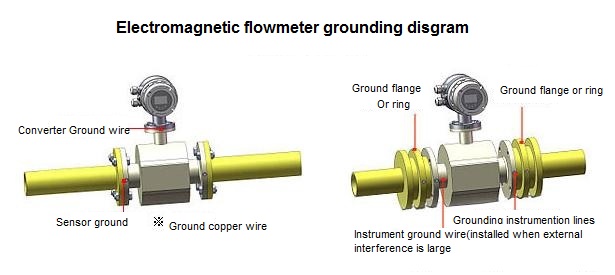How to correctly install the grounding ring of the electromagnetic flowmeter and what role does it play?
The basic principle of electromagnetic flowmeter is based on Faraday's law of electromagnetic induction. The measuring tube of the flowmeter is a short tube of non-magnetic conductive alloy lined with insulating material. Two electrodes are fixed on the measuring tube through the tube wall along the diameter of the tube.
The electromagnetic flowmeter has no moving parts in the pipeline, no blocking parts, and there is almost no additional pressure loss in the measurement. The measurement results are related to physical parameters such as flow velocity distribution, fluid pressure, temperature, density, and viscosity. In the field, the range can be modified online according to the actual needs of users. High-definition backlit LCD display, full Chinese menu operation, easy to use, simple to operate, easy to learn and understand. Using SMD devices and surface mount (SMT) technology, the circuit reliability is high. Adopt 16-bit embedded microprocessor, fast operation speed, high precision, programmable frequency low-frequency rectangular wave excitation, which improves the stability of flow measurement and low power consumption. Full digital processing, strong anti-interference ability, reliable measurement, high precision, flow measurement range up to 150:1. Ultra-low EMI switching power supply, suitable for a wide range of power supply voltage changes, and good anti-EMI performance.
Since the electromagnetic flowmeter cannot measure in the non-conductive medium, the manufacturer will match the grounding ring when using the plastic pipe. The grounding ring of the electromagnetic flowmeter is in direct contact with the medium through the grounding electrode, and then grounded with the instrument flange through the grounding ring to achieve equipotentiality with the ground to eliminate interference.
So what is the function of the electromagnetic flowmeter grounding ring? Is a ground ring necessary? What if there is no ground ring?
1. The function of the grounding ring, the grounding ring directly contacts the medium through the grounding electrode, and then is grounded with the instrument flange through the grounding ring to achieve equipotentiality with the ground to eliminate interference.
2. Use of grounding ring: It is often not suitable to add a grounding ring in some occasions. For example, when measuring strong corrosive media, the pipeline is often made of PVC or PTFE-lined electrodes, and precious metals are selected, especially for large diameters. , then it is impossible to match the ground ring, and the cost is too high. In this case, three electrodes are generally selected, two of which are used for measurement and the other is used for grounding.
How to use the power connection ring correctly for the electromagnetic flowmeter:
Generally, if the pipeline is made of metal, it is not necessary to match the grounding ring. Connect the flange of the flowmeter to the pipeline and then ground it, which can also be used very well, especially in the case of large diameters. If the diameter is small, it does not matter if the grounding ring is provided, and the cost will not be much different. In addition, some users are not measuring strong corrosive media, but their pipelines are non-metallic. At this time, they must be equipped with a grounding ring. Grounding is very important for electromagnetics. The interference of the on-site magnetic field is fatal to electromagnetism, because we can take some measures to shield the electric field, but we cannot shield the magnetic field, so the electromagnetic flowmeter must be installed to avoid strong magnetic fields.
The grounding ring is not omnipotent, and it is often not suitable to use the grounding ring in some occasions. Generally, if the pipeline is made of metal, it is not necessary to match the grounding ring, and the flange of the flowmeter is connected to the pipeline and then grounded, which can also be used very well, especially in the case of large diameters. If the diameter is small, it does not matter if the grounding ring is provided, and the cost will not be much different. In addition, some users are not measuring strong corrosive media, but their pipelines are non-metallic. At this time, they must be equipped with a grounding ring. Grounding is very important for electromagnetics.
When measuring strong corrosive media, the pipes are often made of PVC or lined with tetrafluoride material. At this time, the electrodes are generally selected from precious metals, such as titanium electrodes and tantalum electrodes. However, for large-diameter electromagnetic flowmeters, it is not suitable for grounding rings because of cost considerations. In this case, three electrodes are generally selected, two of which are used for measurement and the other is used for grounding.
The interference of the on-site magnetic field is fatal to electromagnetism, because we can take some measures to shield the electric field, but we cannot shield the magnetic field, so the electromagnetic flowmeter must be installed to avoid strong magnetic fields.
Electromagnetic flowmeter has its unique advantages, so it is widely used in chemical fiber, food, paper, sugar, mining and metallurgy, water supply and drainage, environmental protection, water conservancy and hydraulic engineering, steel, petroleum, pharmaceutical and other industrial fields. Acid, salt solution, mud, ore pulp, paper pulp, coal water slurry, corn steep liquor, fiber pulp, grain pulp, lime milk, sewage, cooling raw water, water supply and drainage, brine, hydrogen peroxide, beer, wort, various beverages, Volume flow of conductive liquid media such as black liquid and green liquid.


